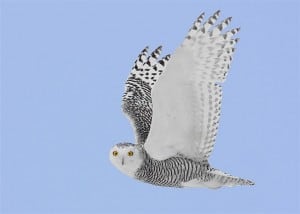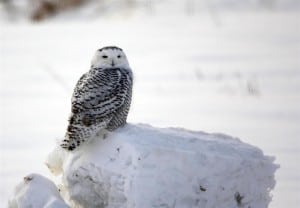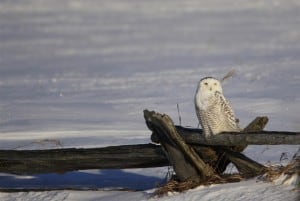On December 9th, I received an email from Nan Campbell concerning a white owl she had seen by the roadside near Hamilton Bay on Stony Lake. As she slowed her car down, the bird flew off low to the ground and landed on a big rock. I knew immediately that what Nan was describing had to be a Snowy Owl. What I did not know, however, was that the bird was part of the vanguard of an unprecedented invasion of these Arctic nomads into eastern North America, including the Kawarthas. Snowy Owls are an irregular winter visitor here and do not show up every year. Most often, they only pass through our area, rarely lingering for more than a day or two.
What we are experiencing this winter is a dramatic spectacle of nature. Although some Snowies move south every winter, this year’s incursion is almost certainly the largest in decades. Sightings have been pouring in from all over Ontario, Quebec, Atlantic Canada and the northeast U.S. Over three hundred birds were seen in one weekend in southeastern Newfoundland. In eastern Ontario, as many as 130 birds have either staked out a winter territory or have moved through the area to points further south. One owl was even seen near Jacksonville, Florida. To date, at least six owls have been recorded in the Kawarthas. They include birds seen near Stony Lake (approximately Dec. 6), Chemong Road (Dec. 10), Trent University (Dec. 17), Pontypool (Dec. 27), Millbrook (Jan. 4), and Oakwood (Jan. 9). As of January 13, the Chemong Road owl was still present (details below).
Why the invasion?
Why have Snowy Owls moved south this winter in such high numbers? Although the exact dynamics of the invasion are far from clear, the first thing to understand is that Snowies are a highly mobile species. In addition to winter movements, these owls sometimes travel a 1000 kilometres or more across the Arctic, even in summer. It is has also long been known that lemming population cycles drive much of the survival and breeding success of Snowy Owls. These birds will even skip an entire breeding seasons when prey is scarce, but may produce large clutches (up to 11 eggs!) when prey is abundant. This past summer, researchers in the eastern Arctic – especially the Ungava Bay area of Quebec – observed exceptionally large clutches of Snowy Owls. The ample supply of lemmings also meant that nearly all of the young owls survived. A picture taken this summer and posted on the Arctic Raptors Facebook page shows a Snowy Owl nest in northern Quebec with 70 lemmings and eight voles brought to the nest even before the eggs had hatched.
It therefore seems likely that the biggest driving force in Snowy Owl invasions is not a lack of lemmings but rather a highly productive breeding season as a result of summer lemming abundance. When exceptionally large numbers of young owls are produced, it would make sense that they have evolved to disperse southward in search of new hunting territories. The high proportion of first-winter (immature) owls during these invasions provides further evidence that high breeding productivity is a major factor. It is also possible that climate change may be playing a role in these southward flights. For example, more snow than usual may be making the lemmings harder to find. The climate in the Arctic is changing dramatically, with major losses in sea ice, significant changes in snowfall from historical means, and a general increase in summer temperatures. Although these invasions have been happening for centuries, a changing climate cannot help but affect lemming cycles, owl cycles and winter prey availability. As of yet, the exact dynamics are not known.
Basic biology
The Snowy Owl is North America’s heaviest owl. Males typically weigh about two kilograms, while females can tip the scales at closer to three. The Snowy Owl is also unique among owls in that the male and female can look decidedly different. The adult male is almost pure white, while the adult female is white with dark barring, much like the immature male. Immature females are darkest of all.
In addition to eating voles and lemmings, Snowy Owls also eat other birds – ducks are especially popular – and even carrion such as dead fish washed up on shore. They will sometimes take prey as large as Arctic Hares. In fact, their Swedish name “harfaong”, means “eater of hares”.
Owl spotting
Not surprisingly, the Snowy Owls that turn up here in winter tend to be found in areas that look most like the Arctic tundra from where they’ve come. This is why open fields, airports and lakeshores are high on their list of preferred habitats. The owls particularly like areas where there are also scattered trees, hummocks or man-made structures from which to get a good view of their surroundings. They often perch conspicuously on tree tops, hay bales, billboards, rooftops, light standards, telephone poles and hydro towers. Former Examiner nature columnist Doug Sadler once took a picture of a Snowy Owl peering down on him from atop the flagpole of St. John’s Anglican Church in downtown Peterborough.
As of this past Monday, the Chemong Road Snowy Owl was still present. A relatively dark-plumaged bird, I found it perched on a hay bale in the field behind McLeod’s Water Treatment. It could have been posing for a Robert Bateman painting! McLeod’s is located on the west side of Chemong Road, just north of the lights at Line 3 (Country Road 19). At other times, it has been seen sitting on the cedar rail fence, on a snowdrift or even on a building. The field is best observed from Line 3, just west of Chemong Road. A pair of binoculars is necessary in order to see the bird well. Your chances of success are probably greatest if you go early in the morning or late afternoon when these owls are most active. Snowy Owls such as this one will often remain in the same area until March or April before returning to the Arctic. If you don’t find the Chemong owl, you are almost guaranteed of seeing Snowy Owls if you make a trip to Amherst Island, just west of Kingston. You may wish to read my article from February 10, 2009 about this wonderful destination for seeing birds of prey.
Remember, however, that it is important not to stress these birds by approaching too closely. Some individuals are probably food-stressed and need peace and quiet in order to hunt to maintain their strength. Continued close approach by birders or photographers can therefore be disruptive. Snowy Owls are large birds and can be enjoyed and photographed from a distance.
I hope readers have a chance to witness this year’s owl invasion first-hand and to feel the special connection these birds provide with the Canadian Arctic. Like phantoms on silent wings, they personify the wildness and romance of the far north. And, although they are facing new threats such as climate change, at least people no longer shoot them. Even fifty years ago, they were slaughtered in great numbers whenever they wandered south. I would appreciate knowing of any Snowy Owls readers may observe. My email address is provided below. I will post the sightings
on my website. You can also report owl sightings – or those of any other bird – by going to ebird.org, registering and submitting a checklist. Keeping track of where and when the owls turn up helps scientists learn more about this iconic bird and its nomadic wanderings.


